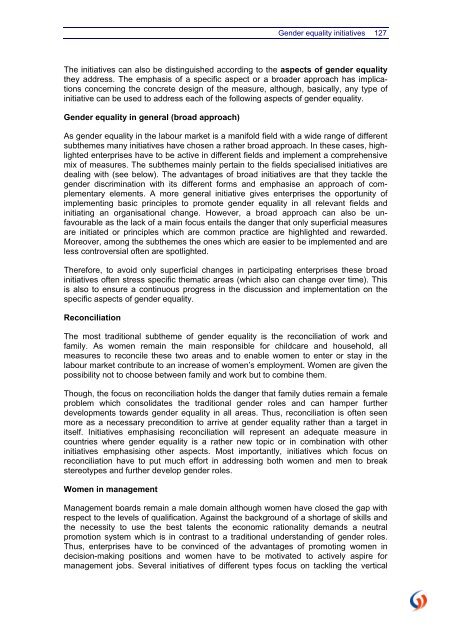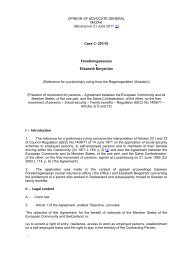Study on non-legislative initiatives for companies to promote gender ...
Study on non-legislative initiatives for companies to promote gender ...
Study on non-legislative initiatives for companies to promote gender ...
You also want an ePaper? Increase the reach of your titles
YUMPU automatically turns print PDFs into web optimized ePapers that Google loves.
Gender equality <strong>initiatives</strong> 127<br />
The <strong>initiatives</strong> can also be distinguished according <strong>to</strong> the aspects of <strong>gender</strong> equality<br />
they address. The emphasis of a specific aspect or a broader approach has implicati<strong>on</strong>s<br />
c<strong>on</strong>cerning the c<strong>on</strong>crete design of the measure, although, basically, any type of<br />
initiative can be used <strong>to</strong> address each of the following aspects of <strong>gender</strong> equality.<br />
Gender equality in general (broad approach)<br />
As <strong>gender</strong> equality in the labour market is a manifold field with a wide range of different<br />
subthemes many <strong>initiatives</strong> have chosen a rather broad approach. In these cases, highlighted<br />
enterprises have <strong>to</strong> be active in different fields and implement a comprehensive<br />
mix of measures. The subthemes mainly pertain <strong>to</strong> the fields specialised <strong>initiatives</strong> are<br />
dealing with (see below). The advantages of broad <strong>initiatives</strong> are that they tackle the<br />
<strong>gender</strong> discriminati<strong>on</strong> with its different <strong>for</strong>ms and emphasise an approach of complementary<br />
elements. A more general initiative gives enterprises the opportunity of<br />
implementing basic principles <strong>to</strong> <strong>promote</strong> <strong>gender</strong> equality in all relevant fields and<br />
initiating an organisati<strong>on</strong>al change. However, a broad approach can also be unfavourable<br />
as the lack of a main focus entails the danger that <strong>on</strong>ly superficial measures<br />
are initiated or principles which are comm<strong>on</strong> practice are highlighted and rewarded.<br />
Moreover, am<strong>on</strong>g the subthemes the <strong>on</strong>es which are easier <strong>to</strong> be implemented and are<br />
less c<strong>on</strong>troversial often are spotlighted.<br />
There<strong>for</strong>e, <strong>to</strong> avoid <strong>on</strong>ly superficial changes in participating enterprises these broad<br />
<strong>initiatives</strong> often stress specific thematic areas (which also can change over time). This<br />
is also <strong>to</strong> ensure a c<strong>on</strong>tinuous progress in the discussi<strong>on</strong> and implementati<strong>on</strong> <strong>on</strong> the<br />
specific aspects of <strong>gender</strong> equality.<br />
Rec<strong>on</strong>ciliati<strong>on</strong><br />
The most traditi<strong>on</strong>al subtheme of <strong>gender</strong> equality is the rec<strong>on</strong>ciliati<strong>on</strong> of work and<br />
family. As women remain the main resp<strong>on</strong>sible <strong>for</strong> childcare and household, all<br />
measures <strong>to</strong> rec<strong>on</strong>cile these two areas and <strong>to</strong> enable women <strong>to</strong> enter or stay in the<br />
labour market c<strong>on</strong>tribute <strong>to</strong> an increase of women’s employment. Women are given the<br />
possibility not <strong>to</strong> choose between family and work but <strong>to</strong> combine them.<br />
Though, the focus <strong>on</strong> rec<strong>on</strong>ciliati<strong>on</strong> holds the danger that family duties remain a female<br />
problem which c<strong>on</strong>solidates the traditi<strong>on</strong>al <strong>gender</strong> roles and can hamper further<br />
developments <strong>to</strong>wards <strong>gender</strong> equality in all areas. Thus, rec<strong>on</strong>ciliati<strong>on</strong> is often seen<br />
more as a necessary prec<strong>on</strong>diti<strong>on</strong> <strong>to</strong> arrive at <strong>gender</strong> equality rather than a target in<br />
itself. Initiatives emphasising rec<strong>on</strong>ciliati<strong>on</strong> will represent an adequate measure in<br />
countries where <strong>gender</strong> equality is a rather new <strong>to</strong>pic or in combinati<strong>on</strong> with other<br />
<strong>initiatives</strong> emphasising other aspects. Most importantly, <strong>initiatives</strong> which focus <strong>on</strong><br />
rec<strong>on</strong>ciliati<strong>on</strong> have <strong>to</strong> put much ef<strong>for</strong>t in addressing both women and men <strong>to</strong> break<br />
stereotypes and further develop <strong>gender</strong> roles.<br />
Women in management<br />
Management boards remain a male domain although women have closed the gap with<br />
respect <strong>to</strong> the levels of qualificati<strong>on</strong>. Against the background of a shortage of skills and<br />
the necessity <strong>to</strong> use the best talents the ec<strong>on</strong>omic rati<strong>on</strong>ality demands a neutral<br />
promoti<strong>on</strong> system which is in c<strong>on</strong>trast <strong>to</strong> a traditi<strong>on</strong>al understanding of <strong>gender</strong> roles.<br />
Thus, enterprises have <strong>to</strong> be c<strong>on</strong>vinced of the advantages of promoting women in<br />
decisi<strong>on</strong>-making positi<strong>on</strong>s and women have <strong>to</strong> be motivated <strong>to</strong> actively aspire <strong>for</strong><br />
management jobs. Several <strong>initiatives</strong> of different types focus <strong>on</strong> tackling the vertical
















